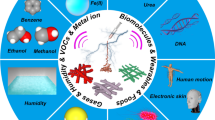Abstract
Micro-sensors are fabricated by co-electrospinning In2O3 and SnO2 nanofibers on the substrates of SiO2/Si with interdigitated Pt signal electrodes. The total sensor area is 1.36 mm × 0.55 mm and the active area is only 0.63 mm × 0.55 mm. Excellent NH3 sensing properties are obtained based on the sensors at room temperature. The sensitivity is at most 28 when the sensors are exposed to NH3 of 10 ppm. The response time is 8 s or so and the recovery time is nearly 2 s. Not only fine selectivity, but also long-time stability is obtained. The results not only demonstrate the obtained micro-sensors are very promising devices for NH3 detection, but also show a possible route for large-scale NH3 sensor fabrication at the industrial level.







Similar content being viewed by others
References
Lee SM, Dyer DC, Gardner JW (2003) Design and optimisation of a high-temperature silicon micro-hotplate for nanoporous palladium pellistors. Microelectron J 34:115–126
Franke ME, Koplin TJ, Simon U (2006) Metal and metal oxide nanoparticles in chemiresistors: does the nanoscale matter? Small 2:36–50
Huang XJ, Cho YK (2007) Chemical sensors based on nanostructured materials. Sens Actuators B 122:659–671
Jing K, Nathan RF, Chongwu Z et al (2000) Nanotube molecular wires as chemical sensors. Science 287:622–625
Kolmakov A, Moskovits M (2004) Chemical sensing and catalysis by one-dimensional metal-oxide nanostructures. Annu Rev Mater Res 34:151–180
Dong Q, Su H, Zhang D et al (2006) Fabrication and gas sensitivity of SnO2 hierarchical films with interwoven tubular conformation by a biotemplate-directed sol–gel technique. Nanotechnology 17:3968–3972
Qi Q, Zhang T, Liu L et al (2009) Improved NH3, C2H5OH, and CH3COCH3 sensing properties of SnO2 nanofibers by adding block copolymer P123. Sens Actuators B 141:174–178
Chambon L, Germain JP, Pauly A et al (1999) A metallic oxide gas sensor array for a selective detection of the CO and NH3 gases. Sens Actuators B 60:138–147
Patil DR, Patil LA, Patil PP (2007) Cr2O3-activated ZnO thick film resistors for ammonia gas sensing operable at room temperature. Sens Actuators B 126:368–374
Douglas RK, Alexader S (2008) Carbon nanotube gas and vapor sensors. Angew Chem Int Ed 47:6550–6570
Comini E, Faglia G, Sberveglieri G et al (2002) Stable and highly sensitive gas sensors based on semiconducting oxide nanobelts. Appl Phys Lett 81:1869–1871
Janata J, Josowicz M, Devaney DM (1994) Chemical sensors. Anal Chem 66:207R–228R
Barsan N, Koziej D, Weimar U (2007) Metal oxide-based gas sensor research: how to? Sens Actuators B 121:18–35
Park JA, Moon J, Lee SJ et al (2010) SnO2–ZnO hybrid nanofibers-based highly sensitive nitrogen dioxides sensor. Sens Actuators B 145:592–595
Patil LA, Patil DR (2006) Heterocontact type CuO-modified SnO2 sensor for the detection of a ppm level H2S gas at room temperature. Sens Actuators B 120:316–323
Arbiol J, Morante JR, Bouvier P et al (2006) SnO2/MoO3-nanostructure and alcohol detection. Sens Actuators B 118:156–162
Kim KW, Cho PS, Kim SJ et al (2007) The selective detection of C2H5OH using SnO2–ZnO thin film gas sensors prepared by combinatorial solution deposition. Sens Actuators B 123:318–324
Ji HM, Lu HX, Ma DF et al (2008) Preparation and hydrogen gas sensitive characteristics of highly ordered titania nanotube arrays. Chin Sci Bull 53:1352–1357
Aygün S, Cann D (2005) Response kinetics of doped CuO/ZnO heterocontacts. J Phys Chem B 109:7878–7882
Liu L, Zhang T, Li SC et al (2009) Micro-structure sensors based on ZnO microcrystals with contact-controlled ethanol sensing. Chin Sci Bull 54:4371–4375
Wang XZ (2012) Improved ethanol, acetone and H2 sensing performances of micro-sensors based on loose ZnO nanofibers. Chin Sci Bull 57:4653–4658
Shen RS, Li XP, Xia XC et al (2012) Comparative investigation of three types of ethanol sensor based on NiO–SnO2 composite nanofibers. Chin Sci Bull 57:2087–2093
Jung SJ, Yanagida H (1996) The characterization of a CuO/ZnO heterocontact-type gas sensor having selectivity for CO gas. Sens Actuators B 37:55–60
Baek KK, Tuller HL (1993) Electronic characterization of ZnO/CuO heterojunctions. Sens Actuators B 13:238–240
Acknowledgments
This work was supported by the National Natural Science Foundation of China (61106050, 21201022, 61205038), the Science Foundation for Young Scholars of Changchun University of Science and Technology (XQNJJ-2011-12), the Scientific and Technological Development Project of Jilin Province (201101103, 201201121, 20120435, 20130203033GX) and the Scientific and Technological Pillar Project of Changchun (11KZ38).
Author information
Authors and Affiliations
Corresponding author
About this article
Cite this article
Liang, Q., Li, D., Gao, S. et al. Room-temperature NH3 sensors with high sensitivity and short response/recovery times. Chin. Sci. Bull. 59, 447–451 (2014). https://doi.org/10.1007/s11434-013-0018-3
Received:
Accepted:
Published:
Issue Date:
DOI: https://doi.org/10.1007/s11434-013-0018-3




